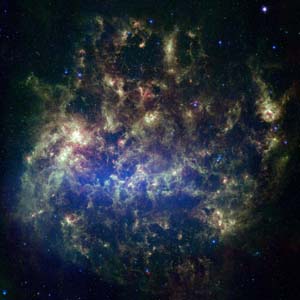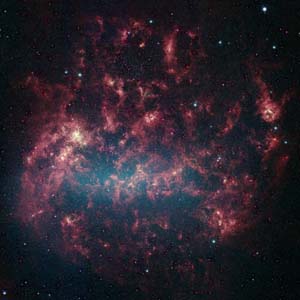Astronomers provide fresh peek at nearby galaxy
An international team of astronomers, including scientists at the University of Wisconsin–Madison, has created two striking images of the Large Magellanic Cloud (LMC), a small galaxy nestled right next to the Milky Way.

Astronomers have created two composite images of the Large Magellanic Cloud, the nearest galaxy to the Milky Way. This image shows the LMC at both lower and higher wavelengths of infrared light, a form of light that is not visible to the human eye. To produce the new visuals, an international group of astronomers — including researchers at the University of Wisconsin–Madison — worked with data collected by the the Spitzer Space Telescope of the National Aeronautics and Space Administration. During its six-year mission orbiting the sun, the Spitzer has been gathering infrared images of objects in the universe.
Image credit: NASA/JPL-Caltech/STScI/Produced by UW–Madison, University of Arizona, Baltimore Space Telescope Science Institute

This image shows the LMC at lower wavelengths of infrared light.
Image credit: NASA/JPL-Caltech/STScI/Produced by UW–Madison, Baltimore Space Telescope Science Institute
Unprecedented in their sensitivity and resolution, the new composites will allow astronomers to delve deeper into a multitude of scientific questions, such as how the universe is evolving, or how stars form and grow in other galaxies.
“These images are very exciting because they are allowing us to gather all kinds of new information about the LMC,” says Edward Churchwell, a professor of astronomy and one of four UW–Madison scientists who contributed to the project.
The Madison team collaborated with researchers at the University of Arizona and Baltimore’s Space Telescope Science Institute to produce the two composite visuals, which are slated to appear in the Astronomical Journal later this year.
The scientists wove together information from thousands of infrared images captured by the Infrared Array Camera and the Multiband Imaging Photometer of NASA’s Spitzer Space Telescope, an orbiting telescope managed by NASA’s Jet Propulsion Laboratory in Pasadena, Calif.
Launched on a six-year mission in 2003, the Spitzer has been collecting snapshots of the universe at infrared wavelengths of light, a form of light that is invisible to the human eye. Examining the universe at such wavelengths is crucial because it allows astronomers to see objects in outer space that would otherwise be impossible to detect. At visible wavelengths, for example, many stars are completely shrouded in swirls of galactic dust. But when viewed with infrared light, the same stars become conspicuous.
“This is one reason why [Spitzer] is providing a new view of pretty much the entire universe, from nearby star formation regions all the way out to the edge of the universe,” says Barbara Whitney, a UW–Madison astronomer who helped create the new images.
Located around 160,000 light years away, the LMC is the nearest galaxy to our own. It can actually be seen with the naked eye, from countries in the Earth’s southern hemisphere. Whitney says it looks like a “smudge” in the night sky that is bigger than a full moon.
To create the new visuals, UW–Madison researchers worked with shorter wavelengths of infrared light, before merging their results with those of their collaborators, who tackled longer infrared wavelengths. While the LMC has been imaged before, previous pictures are relatively blurry in comparison to the new composites, which offer a level of resolution that is enabling scientists to identify millions of LMC stars at mid-infrared wavelengths for the first time, Churchwell says.
That comes as a big boon to both extragalactic astronomers — who have till now been unable to directly view stars in other galaxies — and galactic astronomers, who can now learn more about our own galaxy in relation to the LMC, which is easy to view for the first time.
UW–Madison astronomers Brian Babler and Marilyn Meade also contributed to the project. The initiative is part of the Spitzer Space Telescope Legacy Program, which invites scientists to use Spitzer data to explore intriguing questions about outer space. Any resulting scientific observations are immediately available for free to researchers worldwide.
Science operations for the Spitzer mission are conducted at the Spitzer Science Center at the California Institute of Technology in Pasadena, Calif.
Tags: research




